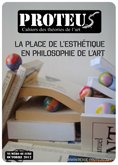Corps à corps œuvre-public : approche esthétique d’une installation
Abstract
 Télécharger l’article
Télécharger l’article
Paru dans : Proteus n°4

Le terme art expérientiel a été inventé par Alva Noë pour désigner un art non exclusivement visuel mais aussi vestibulaire et proprioceptif. Ce type d’œuvre permettrait de faire fonctionner le concept d’enaction inventé par Francisco Varela, en tant que vision subjective du monde, sensorielle et motrice. Nous proposons d’explorer les installations expérientielles en nous appuyant sur la physiologie (Berthoz) et la neurobiologie (Damasio, Varela). De cette analyse émergera la notion de « somagraphie » qui désigne les scénographies plasticiennes destinées spécifiquement à l’éveil sensoriel et à l’augmentation de l’attention accordée au soma.
Mots-clés : art expérientiel — énaction — somagraphie — corps en mouvement — art immersif
The term « experiential art » was invented by Alva Noë to designate artistical forms which are not only visual but also proprioceptive and vestibular. This artwork allows us to understand the concept of enaction, invented by Francisco Varela, which indicates a subjective, sensory and motor vision of the world. We propose to explore experiential art by quoting physiologists (James, Berthoz) and neurobiologists (Damasio, Varela). From this analysis emerges the concept of « somagraphy » which refers to scenography built specifically to arouse sensory awareness and increase the attention paid to soma.
Keywords : experiential art — enaction — somagraphie — body in movement — immersive art








